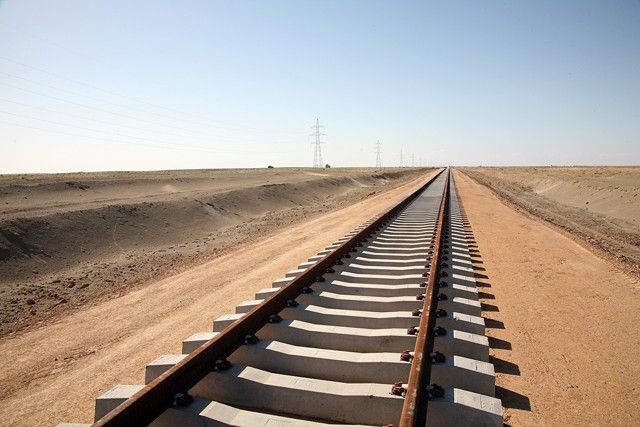BISHKEK (TCA) — The China-Kyrgyzstan-Uzbekistan railway route will be determined in April 2018, participants of the tripartite talks decided in Tashkent in late December. The meeting made decisions on the timing of the project, sources of financing and the development of its feasibility study.
Kyrgyzstan offered an option according to which a $5 billion railroad should run through the regions of the country to contribute to the development of its trade and economic relations.
Breakthrough in cooperation
In early December, during the visit of the President of Kyrgyzstan Sooronbai Jeenbekov to Tashkent, the railway construction project was called historic, and the parties agreed to begin its implementation sooner.
This is a strategically important project for Kyrgyzstan, Jeenbekov said. The more trains will travel through a larger number of settlements the greater will be the benefits for the economic development of the country. The railway will contribute to the development of the Osh province in the south of Kyrgyzstan, and new jobs will be created. The region can export meat, milk, honey and drinking water to China, he added.
The construction of the China-Kyrgyzstan-Uzbekistan railway fully meets the interests of Uzbekistan and Kyrgyzstan. Its early construction will help increase the attractiveness of Central Asia as the most profitable and efficient transit corridor in the region, the Uzbek UzTAG news agency said.
At the end of December in Tashkent, the Kyrgyz State Railway Enterprise, Kyrgyz Temir Jolu, and the Uzbek National Railway Company, Uzbekiston Temir Yollari, signed a protocol of cooperation to implement the agreements reached during the summit of the presidents of the two countries in Tashkent on 13-14 December 2017.
To attract additional cargo transportation, the Kyrgyz side asked the Uzbek Railways for a 30% discount for all goods carried through Uzbekistan towards the stations of the Southern Branch of the Kyrgyz Railway, as well as in the opposite direction, from January 2018.
Uzbekistan is ready to repair diesel locomotives and freight cars owned by Kyrgyz Temir Jolu, and supply spare parts for them on preferential terms.
Background
The project for the construction of the China-Kyrgyzstan-Uzbekistan railway has been under discussion for about 20 years.
In 2002, China developed the project’s feasibility study and the railroad route. Trains were to travel to Uzbekistan through the Torugart Pass (located on the border of the Naryn province of Kyrgyzstan and the Xinjiang Uygur Autonomous Region of China) and southern Kyrgyzstan. The length of the route across Kyrgyzstan was 268 km. It was planned to build 95 bridges and 48 tunnels with a total length of about 50 km.
In 2012, Kyrgyzstan presented its project, according to which the route would run through more areas in the south of the country, and the route was increased to 380 km. The cost of the project ($6 billion) was less due to reducing the number of bridges and tunnels. Later, Kyrgyzstan proposed several more options.
The Kyrgyz side offered two options for implementing the project — through concession or creation of a joint venture. China agreed to the first option, which provided attraction of foreign investment. After the investments have been paid off, the railroad should be transferred to the Kyrgyz side.
The project’s goal
The project aims to shorten the delivery time of Chinese goods to the countries of the Persian Gulf and the EU. For many countries, this route will be the shortest from China. According to preliminary calculations, the reduction of the route from East Asia to the countries of the Middle East and Southern Europe will be about 900 km, and the delivery time will be decreased by 7-8 days.
The project will benefit not only the Chinese economy, but also the countries on whose territory the new railway will pass. For Kyrgyzstan and Uzbekistan, construction will guarantee the further development of transport infrastructure, as well as provide access to the ports of the Persian Gulf and the Pacific.
The China-Kyrgyzstan-Uzbekistan railroad will help develop growth points along it including an industry-oriented free economic zone in Osh to process local raw products and export them using new transport corridors that will reduce the price of the goods due to lower transportation costs.
Different opinions
The China-Kyrgyzstan-Uzbekistan railroad does not promise to become very convenient because it will be necessary to change the wheels with a 1520 mm width on the Chinese-Uzbek border, and to return to the 1435 mm European width on the Turkmen-Iranian border, some experts say.
This road is necessary first to China, then to Uzbekistan, and only then to Kyrgyzstan in case the North-South railway branch is built. Poor development of the internal network greatly reduces the benefits of the project.
However, Uzbek experts believe that the railroad will be no less convenient than the existing ones. For instance, when the cargo is transported by train from China to Germany, it goes through Kazakhstan, Russia, and Eastern Europe, with two shifts of wheels on the border of China and Kazakhstan and then on the border with the Eastern European countries.
Alternative motor road
The railway construction is a long-term and costly project, and a similar North-South alternative motor road project was developed in Kyrgyzstan.
In the Soviet time, there was no problem of cargo transportation from the northern and southern parts of Kyrgyzstan through Tajikistan or Uzbekistan, since everything happened in a single national economic complex.
After the collapse of the Soviet Union, problems arose due to newly established state borders between the countries, and the main transportation load fell on the Bishkek-Osh road. The track is overloaded, and its coating quickly deteriorated. Moreover, traffic jams often occur on the Too Ashuu Pass. All this prevents sustainable traffic.
Construction of a 433 kilometers long alternative motor road from Balykchi in the Issyk-Kul province to Jalal-Abad in the south began in 2014. The project was divided into three phases.
Within the first phase, a 154 km road was built for a $400 million loan from the Export-Import Bank of China. The China Road and Bridge Corporation is now implementing the second phase of the project, the Ministry of Transport and Roads of Kyrgyzstan said.
Unlike the existing Bishkek-Osh road, there are no passes on the alternative one which passes through Naryn and Jalal-Abad provinces. Two overpasses with a length of 400 and 1,086 meters will be built on the highway over the Naryn River.
According to Kyrgyz expert Kubat Rakhimov, the North-South alternative motor road aims to ensure the future cargo potential of the China-Kyrgyzstan-Uzbekistan railway and to strengthen China’s commodity expansion in the densely populated Fergana Valley, as well as to develop cross-border routes from China through Central Asia countries to Afghanistan, Iran and Turkey.









